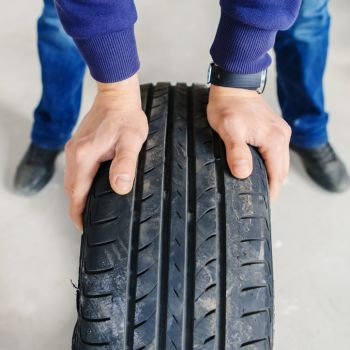 Treads give your tires the traction needed for a safe, consistent and smooth ride. Yet their depth gradually wears down from the miles driven and where you take your car. If you ignore this issue, you could end up with bald tires, which present multiple safety hazards for yourself and passengers.
Treads give your tires the traction needed for a safe, consistent and smooth ride. Yet their depth gradually wears down from the miles driven and where you take your car. If you ignore this issue, you could end up with bald tires, which present multiple safety hazards for yourself and passengers.
What Are Bald Tires?
Tires are manufactured to have a thicker, grooved tread designed to improve grip and contact with the road and make navigation more reliable. Yet the longer you drive, the more these treads start to diminish in size. The grooved appearance disappears, resulting in smaller indents, a smooth appearance or visible wear bars.
New car tires have a tread depth of 10/32 to 12/32 inches. They enter the bald range once the tread is worn down to 2/32 inches. To determine the depth, try the penny test: If you can see the top of Lincoln’s head once you insert the penny into the groove, the tire depth has reached 2/32 inches.
In addition to extensive driving and failing to periodically check your tires, the following factors can cause treads to wear down sooner:
- Underinflated tires, which place greater stress on the tire wall
- Driving with a heavy load, which places greater force on the tires
- Poor alignment, which results in uneven tread wear
- Unbalanced tires, which can result in greater wear to the front two tires
Along with these points, visible wear may be accompanied by cracked or bulging rubber, indicating an internal issue with one or both tires.
Risks of Driving on Bald Tires
Ignoring tire maintenance or driving on bald tires increases your accident risks. The material is more likely to be punctured from road debris and the flatter surface cannot properly divert water, decreasing traction in the rain, snow and on ice. You’re more likely to lose control, spin out or experience a tire blowout.
Driving on bald tires also heightens the risk of:
- Hydroplaning: Rain can create a slick surface that tires with shallower grooves cannot navigate. Being unable to divert water decreases traction and increases risks for sliding around, losing control and spinning out. As a result, you could hit another motorist or property.
- Difficulty Driving In Snow: Even after shoveling your driveway, the traction grooves on your tires help you move slowly, yet reliably and navigate slick or rough areas. Bald tires can either cause you to slide around or may spin as you’re attempting to move your car.
- Braking Issues: While bald tires don’t have a direct effect on brake performance, the absence of treads means you need to start applying pressure sooner to stop. You’ll also find that you can’t make short, last-minute stops and may end up colliding with another car, property or animal.
- Increased Damage: Bald tires are more susceptible to tears and punctures due to the thinner material. You’re more likely to experience a flat or blowout after driving over road debris or a rough surface. Also, heat is more likely to accumulate around a set of bald tires, softening the material and decreasing the effects of friction.
- Decreasing Air Pressure: If you’re driving around on bald tires, you may find your set cannot efficiently hold onto air pressure. This further affects their contact with the road and your ability to control your vehicle, which can decrease fuel economy.
- Inconsistent Driving: Due to the cumulative effects of all these factors, you may find that your car is difficult to handle. You may skid more frequently or overaccelerate.
- Breaking the Law: Many states consider bald tires illegal, so driving on them can result in a citation and fine. If you’re involved in an accident, lack of treads can automatically put you at fault.
How to Avoid Driving on Bald Tires
To reduce your risks of driving on bald tires:
- Check your tires at least once a month, ideally with a measuring tool or the penny method.
- Replace your tires once the treads reach 4/32 in. Anything lower increases your risks for losing control.
- Pay attention to the wear or indicator bars. If you can see these raised, horizontal bars about the size of a pencil, your treads have worn down too far.
Before you experience a blowout or hydroplaning due to worn tires, have DaSilva’s Auto Body adjust your vehicle’s alignment and balance your tires. To schedule service, contact us today.




